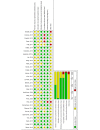Virtual Reality for Health Professions Education: Systematic Review and Meta-Analysis by the Digital Health Education Collaboration
- PMID: 30668519
- PMCID: PMC6362387
- DOI: 10.2196/12959
Virtual Reality for Health Professions Education: Systematic Review and Meta-Analysis by the Digital Health Education Collaboration
Abstract
Background: Virtual reality (VR) is a technology that allows the user to explore and manipulate computer-generated real or artificial three-dimensional multimedia sensory environments in real time to gain practical knowledge that can be used in clinical practice.
Objective: The aim of this systematic review was to evaluate the effectiveness of VR for educating health professionals and improving their knowledge, cognitive skills, attitudes, and satisfaction.
Methods: We performed a systematic review of the effectiveness of VR in pre- and postregistration health professions education following the gold standard Cochrane methodology. We searched 7 databases from the year 1990 to August 2017. No language restrictions were applied. We included randomized controlled trials and cluster-randomized trials. We independently selected studies, extracted data, and assessed risk of bias, and then, we compared the information in pairs. We contacted authors of the studies for additional information if necessary. All pooled analyses were based on random-effects models. We used the Grading of Recommendations, Assessment, Development and Evaluations (GRADE) approach to rate the quality of the body of evidence.
Results: A total of 31 studies (2407 participants) were included. Meta-analysis of 8 studies found that VR slightly improves postintervention knowledge scores when compared with traditional learning (standardized mean difference [SMD]=0.44; 95% CI 0.18-0.69; I2=49%; 603 participants; moderate certainty evidence) or other types of digital education such as online or offline digital education (SMD=0.43; 95% CI 0.07-0.79; I2=78%; 608 participants [8 studies]; low certainty evidence). Another meta-analysis of 4 studies found that VR improves health professionals' cognitive skills when compared with traditional learning (SMD=1.12; 95% CI 0.81-1.43; I2=0%; 235 participants; large effect size; moderate certainty evidence). Two studies compared the effect of VR with other forms of digital education on skills, favoring the VR group (SMD=0.5; 95% CI 0.32-0.69; I2=0%; 467 participants; moderate effect size; low certainty evidence). The findings for attitudes and satisfaction were mixed and inconclusive. None of the studies reported any patient-related outcomes, behavior change, as well as unintended or adverse effects of VR. Overall, the certainty of evidence according to the GRADE criteria ranged from low to moderate. We downgraded our certainty of evidence primarily because of the risk of bias and/or inconsistency.
Conclusions: We found evidence suggesting that VR improves postintervention knowledge and skills outcomes of health professionals when compared with traditional education or other types of digital education such as online or offline digital education. The findings on other outcomes are limited. Future research should evaluate the effectiveness of immersive and interactive forms of VR and evaluate other outcomes such as attitude, satisfaction, cost-effectiveness, and clinical practice or behavior change.
Keywords: health professions education; meta-analysis; randomized controlled trials; systematic review; virtual reality.
©Bhone Myint Kyaw, Nakul Saxena, Pawel Posadzki, Jitka Vseteckova, Charoula Konstantia Nikolaou, Pradeep Paul George, Ushashree Divakar, Italo Masiello, Andrzej A Kononowicz, Nabil Zary, Lorainne Tudor Car. Originally published in the Journal of Medical Internet Research (http://www.jmir.org), 22.01.2019.
Conflict of interest statement
Conflicts of Interest: None declared.
Figures




References
-
- World Health Organization. 2016. Mar 02, [2019-01-14]. High-Level Commission on Health Employment and Economic Growth https://www.who.int/hrh/com-heeg/en/
-
- Frenk J, Chen L, Bhutta ZA, Cohen J, Crisp N, Evans T, Fineberg H, Garcia P, Ke Y, Kelley P, Kistnasamy B, Meleis A, Naylor D, Pablos-Mendez A, Reddy S, Scrimshaw S, Sepulveda J, Serwadda D, Zurayk H. Health professionals for a new century: transforming education to strengthen health systems in an interdependent world. Lancet. 2010 Dec 04;376(9756):1923–58. doi: 10.1016/S0140-6736(10)61854-5.S0140-6736(10)61854-5 - DOI - PubMed
-
- Transformative scale up of health professional education: an effort to increase the numbers of health professionals and to strengthen their impact on population health. Geneva: World Health Organization; 2011. [2019-01-14]. http://apps.who.int/iris/handle/10665/70573 .
Publication types
MeSH terms
LinkOut - more resources
Full Text Sources
Medical

